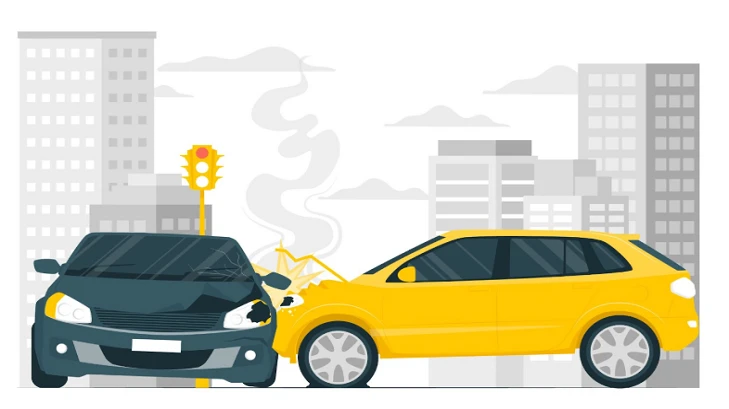- Author: Richard Stim
- Jul 08, 2025
Broadside collisions, also known as T-bone or side-impact crashes, commonly happen at intersections when one vehicle’s front end impacts the passenger side of another at a right angle.
Most collisions occur on the vulnerable side of the vehicle, are notably dangerous, and can lead to severe injuries or fatalities. Unfortunately, safety features like seat belts and airbags are typically less effective in mitigating harm during broadside collisions than front-end impacts, placing occupants at a higher risk of severe injuries after the accident.
What is a broadside collision?
Broadside collision is a two-vehicle accident in which the front side of the vehicle collides with the side of another vehicle. These collisions mostly occur at intersections. In broadside collisions, one of the vehicles fails to yield the right of way at the yield sign, stop sign, or red traffic signal.

Common Causes Of Broadside Collisions
Broadside collisions, also known as T-bones or side-impact crashes, can result in serious consequences due to the vulnerable nature of a vehicle’s sides. Here are five common causes of broadside collisions:
- Intersection Violations: Failing to yield the right of way or running red lights at intersections can lead to vehicles colliding at right angles.
- Distracted Driving: Inattention to traffic signals or failure to notice oncoming vehicles due to distractions such as texting, adjusting controls, or reckless driving contributes to broadside collisions.
- Speeding: Excessive speed reduces reaction time, making stopping or yielding at intersections more challenging and increasing the likelihood of broadside collisions.
- Impaired Driving: Driving under the influence of alcohol or drugs impairs judgment and coordination, leading to a higher risk of misjudging intersections and causing side-impact collisions.
- Failure to Obey Stop Signs: Disregarding stop signs or rolling through stop-controlled intersections without a complete stop can result in broadside collisions, especially when other vehicles have the right-of-way.
Common Injuries In Broadside Crashes
Broadside crashes often result in serious injuries due to the direct impact on the side of the vehicle. Victims may suffer traumatic brain injuries after car accidents, especially when the head strikes the window or door frame.
Spinal cord injuries after car accidents are also common, potentially leading to long-term mobility issues or paralysis, along with broken bones, internal organ damage, and soft tissue injuries. Common injuries in broadside crashes include:
- Traumatic Brain Injuries
- Chest and Abdominal Injuries
- Spinal Injuries
- Pelvic and Hip Injuries
- Arm and Leg Injuries
Intersections Are Planned Points Of Conflict
The U.S. Federal Highway Administration (FHWA) is responsible for monitoring, researching, and regulating America’s roads and highways and their safety. The FHWA spends millions of dollars studying intersections, also known as planned points of conflict. Twenty percent of traffic deaths and 40 percent of injuries due to traffic-related accidents happen at intersections, which makes it necessary to enhance road safety awareness.
On an estimate, 50% of traffic accidents at intersections are almost broadside collisions, making these accidents the most commonly occurring motor vehicle accidents at intersections.
Improvements in Vehicle Safety Reduce the Broadside Collision Injuries
The National Highway Transportation Safety Administration (NHTSA) has changed its side-impact testing process in response to the vehicle size-injury connection. Manufacturers may design and build vehicles that provide impact safety for front and rear passengers. It will provide enhanced restraint systems and structural support. Front and rear side curtains are installed in some vehicles for greater broadside impact protection.
Do Roundabouts Prevent Broadside Collisions at Intersections?
According to the Federal Highway Administration (FHWA), roundabouts are among the proven safety countermeasures that can help reduce road fatalities. They channel drivers into a circular pattern and minimize conflict points, allowing vehicles to collide.
Nearly an 82% reduction in fatal and injury accidents after stopping in two-way roundabouts. The crashes were also reduced by 78% after creating a roundabout transformation. Reduced conflict and lower speeds create a better walking environment for the people.
Distinctive Features Related To Driving Through Intersections
Broadside accidents mainly occur at intersections. Some of the key features associated with driving through intersections are as follows:
- Traffic Signals: Intersections commonly feature traffic signals that dictate when drivers should stop, proceed with caution, or yield. Understanding the meaning of different signal phases, such as green, yellow, and red, is crucial for safe navigation.
- Stop Signs: Some intersections are controlled by stop signs, requiring drivers to come to a complete stop before proceeding. Adherence to these signs is essential for maintaining order and preventing collisions.
- Right-of-Way Rules: Knowing right-of-way rules is vital. Yielding to oncoming traffic, pedestrians, or vehicles with the right-of-way helps prevent accidents. Understanding who has the right-of-way in various situations enhances overall intersection safety.
- Pedestrian Crosswalks: Intersections often include marked crosswalks for pedestrians. Drivers must be attentive to pedestrians and yield to them when they have the right of way. Increased pedestrian activity requires careful consideration.
- Left-Turn Hazards: Left-turning vehicles pose a potential hazard, especially when crossing the path of oncoming traffic. Drivers must gauge the timing and yield appropriately to prevent collisions.
- Visibility Challenges: Intersections like buildings or vehicles at parking lots may have obstructions, limiting visibility. Checking blind spots and being cautious when approaching obstructed intersections is crucial to avoid surprises.
- Intersection Geometry: The layout and geometry of an intersection can vary. Understanding the specific configuration, such as whether it’s a four-way intersection, a T-intersection, or a roundabout, helps drivers anticipate traffic flow.
- Communication with Other Drivers: Clear communication with other drivers through turn signals, hand signals, and eye contact is vital for preventing confusion and ensuring a smooth traffic flow through the intersection.
- Traffic Flow: Recognizing the overall traffic flow and anticipating the movements of other vehicles is essential. This includes awareness of merging lanes, multiple turn lanes, and other factors influencing the intersection dynamics.
By being aware of and respecting these distinctive features, drivers can navigate intersections safely, reducing the risk of accidents and promoting efficient traffic flow.
Immediate Steps After A Broadside Collision
In the aftermath of a broadside collision, swift and effective actions are crucial for ensuring safety and facilitating a smoother resolution. Here are five immediate steps to take after a broadside collision:
-
Check for Injuries: Prioritize the safety of all involved parties by checking for injuries. Seek medical attention for anyone in need and call emergency services if necessary.
-
Move to a Safe Location: Move vehicles to a safe location to avoid further risks from oncoming traffic. Turn on hazard lights to alert others to the accident.
-
Exchange Information: Collect and exchange information with the other parties, including names, contact details, insurance information, and vehicle details. Document the scene with photos if possible.
-
Contact Law Enforcement: Call the police to report the accident. A police report can be valuable for insurance claims and legal purposes.
-
Gather Witness Information: If there are witnesses, obtain their contact information. Their statements may be crucial for establishing the sequence of events during the broadside collision.
Damages You Can Recover After a Broadside Collision
When you sustain severe injuries after a broadside collision, your main focus must be on your recovery. Some damages that you may recover are:
- Past, present, and future medical bills
- Rehabilitation costs
- Lost wages
- Loss of companionship
- Pain and suffering
- Emotional distress
- Home remodel costs
Do I Need An Attorney For My Broadside Collision Injuries?
If you sustain injuries in a broadside collision, an experienced car accident lawyer can assist by navigating complex legal processes, gathering evidence to establish liability, and negotiating with insurance companies. Legal representation is invaluable in pursuing personal injury claims and protecting victims’ rights throughout the legal proceedings.
FAQs: Where Do Broadside Collisions Most Commonly Occur
What is a broadside collision?
A broadside collision, also known as a T-bone accident, occurs when the front of one vehicle strikes the side of another vehicle. These crashes often happen when one driver fails to yield the right of way.
Where do broadside collisions most commonly occur?
Broadside collisions most commonly occur at intersections, especially those with traffic lights or stop signs. They often happen when a driver runs a red light, ignores a stop sign, or misjudges another vehicle’s speed.
Are intersections without traffic signals more dangerous for broadside crashes?
Yes. Uncontrolled intersections or intersections with only stop or yield signs can be especially dangerous because drivers may be confused about right-of-way or fail to come to a complete stop.
Do broadside collisions happen in parking lots?
Yes, broadside collisions can occur in parking lots, particularly near exit lanes or blind corners where visibility is limited and drivers are moving in different directions.
Can broadside collisions occur on highways?
While less common, broadside collisions can happen on highways, especially at entrance and exit ramps where vehicles merge or cross lanes at different speeds.
Why are intersections a high-risk area for broadside accidents?
Intersections require drivers to monitor multiple directions, traffic signals, pedestrians, and turning vehicles at once. Distractions, speeding, or failure to yield can easily lead to a T-bone collision.
Are urban areas more prone to broadside collisions?
Yes, urban areas typically have more intersections, heavier traffic, and frequent stops, all of which increase the risk of broadside collisions compared to rural areas.
How can drivers reduce the risk of a broadside collision?
Drivers can reduce risk by obeying traffic signals, slowing down at intersections, checking both directions before proceeding, and avoiding distractions while driving.


